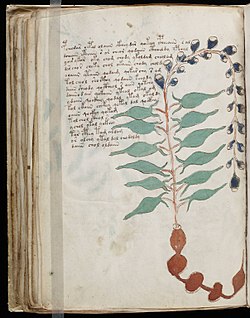
Back مخطوطة فوينيتش Arabic Manuscritu Voynich AST Voyniç əlyazması AZ Рукапіс Войніча BE Рукапіс Войніча BE-X-OLD Ръкопис на Войнич Bulgarian ভয়নেচ পাণ্ডুলিপি Bengali/Bangla Manuscrit Voynich Catalan Voynichův rukopis Czech Voynich-manuskriptet Danish


The Voynich manuscript is a manuscript named after Wilfrid Voynich who bought it in the early 20th century. The manuscript is made up of about 240 vellum pages, and was probably written in the early 15th century[1] in northern Italy. Today, it is in the library of Yale University.
Many pages contain illustrations. Although many authors have been thought to have written this manuscript, the author remains unknown. The text is written in an unknown language, in an unknown writing system. It looks like there are no errors in the text. There are no corrections to it. The text is probably some ciphertext; many people working in cryptography have tried to break its code, both amateur and professional cryptographers. Much less attention has been given to the illustrations, which seem to show plants, anatomic or astronomic links. It has been described as "the world's most mysterious manuscript".[2]
In 2009, University of Arizona researchers performed radiocarbon dating on the manuscript's vellum, which they say (with 95% confidence) was made between 1404 and 1438.[1][3] In addition, the McCrone Research Institute in Chicago found that much of the ink was added not long afterwards, confirming that the manuscript is an authentic medieval document.[3]
- ↑ 1.0 1.1 "Experts determine age of book 'nobody can read'". Retrieved 2011-02-10.
- ↑ Robert S. Brumbaugh, The World's Most Mysterious Manuscript, Weidenfeld and Nicholson, London, (1977)
- ↑ 3.0 3.1 Mysterious Voynich manuscript is genuine – Evidence in 2009 showing that the manuscript is indeed old as had been suspected